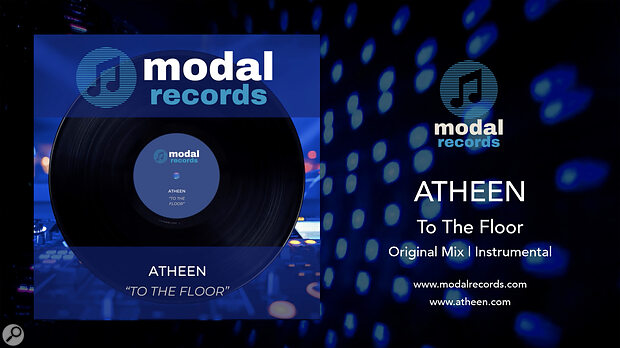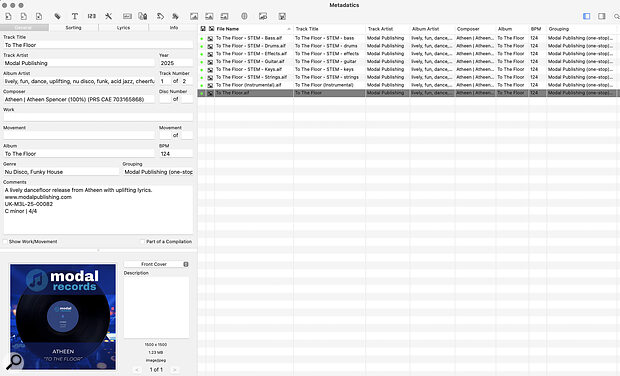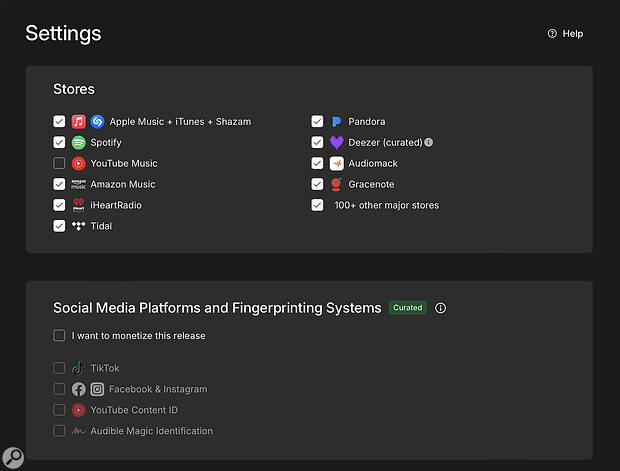 Your artwork is important — but be sure to acquaint yourself with the dimensions and other rules before trying to upload it.
Your artwork is important — but be sure to acquaint yourself with the dimensions and other rules before trying to upload it.
With our nu‑disco tune mixed and mastered, we turn our attention to distributing and promoting it...
In previous articles, we’ve described using SOS For Artists (SOSFA) to create, mix and master a nu‑disco track. Now for the final steps: distribution and promotion. There’s no single ‘right’ way to promote a tune, but while most independent artists won’t want to spend big bucks, following some common industry practices might just boost a track’s ‘discoverability’. Before all that, though, we need to give our song a name! After brainstorming around 30 potential titles, ‘To The Floor’ emerged as our favourite, and also inspired a topline idea that resulted in a vocal version.
The next step was to gather together all the assets necessary for the release campaign. Alongside the audio, you’ll usually need graphics, videos and written content. Typically, it’s best to create video content first, and then take screenshots for your artwork and promotional visuals. But not everyone will have the skills, budget or time to produce a traditional music video; more on this below. In this case, we decided to focus first on the artwork, and then to produce a simple ‘artwork video’ based on it.
Release Artwork
For SOSFA, the minimum spec for your main artwork image is 1500 x 1500 pixels. We’d recommend at least 3000 x 3000 pixels — that will look good if anyone needs to print it at 300dpi, and is of sufficient quality that you’re ‘future‑proofed’. The maximum supported size is 6000 x 6000 pixels, and any image must adhere to this 1:1 aspect ratio (in other words, it must be square). If you’re ‘borrowing’ images from elsewhere, then do be sure to check the usage rights. You should keep any text on the image to a minimum; only the artist and track name are allowed. And you can export a smaller version for use with track listings and online promotion.
You’ll need to use a third‑party tool to create your artwork, and while it’s possible to do this with various phone apps now, if you want to take your graphics more seriously then Photoshop, Canva and Affinity Photo are all capable and popular tools. While you’re focused on designing your graphics, consider also creating some themed headers that you can use to freshen up your website and social profiles on release day. And with an eye on the later promotion phase, you could create other social graphics now too — some imagery promoting merchandise, tour dates and launch parties, for example.
Simple Videos
SOSFA’s focus is on distributing your music, not videos but, like it or not, videos are a necessity when promoting your music today. Thankfully, creating them needn’t be daunting.
 While SOSFA focuses on the audio side, videos can be an important promotional tool — and if you’ve not made one, creating something useful based on your artwork might be less onerous than you imagine!
While SOSFA focuses on the audio side, videos can be an important promotional tool — and if you’ve not made one, creating something useful based on your artwork might be less onerous than you imagine!
Those who are comfortable on camera can shoot their own footage and turn it into a music video. Or you might simply film a live performance. You could also hire freelancers or connect with fellow creators on the SOS Forum to fill any skill gaps (after all, building a strong team is key to any successful endeavour!). But if performing on camera or motion graphics aren’t your strength and you want to go it alone, then simple lyric videos could be a good option. These remain a popular choice, and you can use a basic video editor to overlay lyrics onto background images, just adding fades or simple animations between them. Aligning text on the timeline can take a little time, but it’s a great opportunity to get creative with fonts and visuals to tell a story.
Since we’re releasing a nu‑disco track, we thought a glitterball‑themed promo video the perfect choice! To create it, we downloaded a royalty‑free seamless loop from our own Canva subscription (www.canva.com). You can buy Canva’s stock footage for a modest fee if you’re not a subscriber, but there are lots of other places where you can source royalty‑free footage too. We then edited the video in DaVinci Resolve (there’s a free version if you’re new to video editing: www.blackmagicdesign.com/uk/products/davinciresolve), layering artwork and text on top, to create our simple animated visual.
With a 16:9 (widescreen landscape) video ready for YouTube, and a shorter Facebook edit, a 9:16 (portrait, for mobile phones) version was created for Instagram, YouTube Shorts and Spotify Canvas (the looping visuals that accompany some Spotify releases). You can’t cover every platform, but it makes good sense to focus on the few platforms where your audience is likely to be most active, and these cover a lot of bases.
The Boring Part!
With the visuals in the bag, it’s time to don your ‘record label’ hat. Start by organising your track’s metadata, ideally in a spreadsheet like Excel, with columns for ISRC, track and product titles, mix version, release date, credits, duration, catalogue number, bpm, key, genre, description, and keywords. Not all of that is strictly required for release, but it will make promotion and uploads to sync platforms much easier.
 It’s a good idea to get all your metadata together in advance, in a spreadsheet...
It’s a good idea to get all your metadata together in advance, in a spreadsheet...
Let’s look at ISRC codes first. This is an international identifier for your tracks, and typically it’s assigned automatically during distribution. If you’re running your own label, you can obtain a unique three‑digit identifier and country code through PPL in the UK (if you’re elsewhere you can find your local Performing Rights Organisation at: https://isrc.ifpi.org/contacts/isrc-agency-contacts). The code combines the country abbreviation, identifier, year, and a five‑digit track number; for example ‘UK‑M3L‑25‑00082’. Be sure to assign a separate ISRC for every mix of each track, including each stem group that you’ll be uploading for sync.
In the description column, you should include a brief sentence or two about the track’s style. For keywords, add 15‑20 terms reflecting its mood. For example: ‘upbeat’, ‘lively’, ‘sad’, or ‘ominous’. Catalogue and barcode numbers are generated automatically by the SOSFA platform, so these fields can be filled in later.
 ...and you can then manage it in a third‑party app such as Metadatics. Note that you’ll need metadata for each version you release, including any stems intended for sync.
...and you can then manage it in a third‑party app such as Metadatics. Note that you’ll need metadata for each version you release, including any stems intended for sync.
Next, add your metadata to the tracks, starting with the release audio. There are lots of dedicated tagging tools that can make this straightforward; we used the Mac‑only Metadatics (www.markvapps.com/metadatics) and entered the Title, Artist, Album (you could put a single’s name here), Genre, Year, and bpm. For sync purposes, duplicate your audio folder. In your metadata program, add your full name and PRO registration number in the Composer field and, if you are the sole rightsholder and can offer instant clearance, enter ‘One Stop’ in the Group field. Include a contact email address here as well. Use the comments box for a brief track description, website, contact info, ISRC, Key, and Time Signature. Finally, paste in your comma‑separated keywords — the album artist field works well for this, since it’s searchable.
Electronic Press Kit & Press Release
Traditional physical media packs have largely been replaced by Electronic Press Kits (EPK), hosted on your own website or platforms like DISCO (www.disco.ac), which seems to be gaining popularity. Make sure it includes your artist name, promotional and release images, track listing, release date, credits, biography, contact info, target markets and a list of a few well‑known artists with a similar sound. Include several high‑res professional images so that journalists can easily find what they need.
You’ll also need a press release, which sounds grand but is super‑easy! We’d suggest creating a one‑page A4 Word document and including your contact details and a logo at the top. Begin with ‘FOR IMMEDIATE RELEASE’, add your promotional text, and end with ‘###’ or ENDS to signal the end of the release. The release should briefly outline your achievements and highlight your latest release, but do try to write something original and engaging to attract attention!
Distribution & Registration
With all materials in place, it’s time for distribution and registration. A release date 4‑8 weeks ahead is ideal, but this track had a faster turnaround, and SOSFA can get releases live in as little as 2‑7 days if your profile is already set up — though allowing more time obviously helps with pre‑release promotion.
In SOSFA, go to the Distribution tab and select ‘Add Release.’ With all assets and metadata ready, uploading is straightforward. Click into each track to enter title, artist, mix version and other details. The platform will automatically flag any missing information. On the Release Info tab, add yourself as the composition owner, and either you or your label name as the master recording owner, according to your PPL registration. The Cover Art tab lists artwork guidelines as a helpful reminder.
 With all your data prepped, and your campaign materials ready, uploading your release to SOSFA is easy — and you’ll be given a friendly nudge if you miss any important information.
With all your data prepped, and your campaign materials ready, uploading your release to SOSFA is easy — and you’ll be given a friendly nudge if you miss any important information.
The Release Settings tab lets you choose distribution platforms, set your release date, and opt for SOSFA to collect YouTube royalties for you — useful if your channel isn’t yet monetised. The final page allows you to review all information before submitting. You can save and return later for a final check if you prefer — mistakes can be corrected after submission, but updates may take a couple of weeks to appear.
 You can choose which of the major platforms your release will be distributed to, and have the option to distribute to numerous smaller sites and stores too.
You can choose which of the major platforms your release will be distributed to, and have the option to distribute to numerous smaller sites and stores too.
Once your track is approved for distribution, register it with your local Performing Rights Organisation (PRO) to collect royalties. Here in the UK, this is the Performing Rights Society, or PRS (www.prsformusic.com). Membership requires ID and a small fee, but it should pay off if you are actively promoting your music to radio and submitting your live performance information. Once registered, adding your songs is a quick process, especially if you use the metadata database we discussed above.
If you’re running a label, you’ll also need to register your release with the organisation that issued your ISRC code, in our case PPL UK. Registration is free and you can set up a rightsholder account as an individual or under your label if registered as a company. Uploading is straightforward: register individual tracks first, then create a separate registration for the overall release, in this case a single with two mixes. It’s advisable to wait for PRS registration confirmation first, since you can link the two databases by adding in the ISWC (International Standard Musical Work Code) provided by PRS.
Finally, add your release to MusicBrainz (https://musicbrainz.org) for industry visibility and use Discogs (www.discogs.com) to give even more visual presence, particularly if you’re releasing physical formats too.
You might be getting an idea of how good record labels actually earn their share of the income!
The Release Campaign
By now, you might be getting an idea of how good record labels actually earn their share of the income! While there’s still more legwork to come, it’s perfectly normal to start small with your first release campaign, and increase your efforts with each new release, as you acquire more contacts and followers.
There are three main groups on whom, ideally, you need to target your promotion efforts:
- The media — under which heading we’d include DJs, radio stations, blogs, magazines, reviewers, tastemakers, playlists, venues, and so on.
- Music supervisors for sync.
- Your fanbase.
Note that your focus should be on building long‑term, mutually beneficial relationships. To that end, if you’re taking your music career seriously, consider hiring a promoter or enlisting a friend to help ease the workload. But even without that, you can start building your contact list by searching locally and online for industry professionals in your genre. Use Google, LinkedIn, and attend events with business cards to grow your network. Contact each person individually where possible, sharing a brief introduction and a link to your press kit, and offer the option to join a mailing list (never add contacts automatically; in many countries it’s illegal, and in any case you want people to notice you, not report you as a spammer!). Make sure the tracks on your EPK are actually downloadable.
Emerging artists can upload their track to BBC Introducing (www.bbc.co.uk/introducing) for potential local radio coverage and pursue interviews with local and national publications, TV, radio and online outlets. Try to arrange interviews to coincide with gig dates in that area. You can use the SOSFA Promotion tab to set up your official Spotify for Artists account, where you can apply to be featured on Spotify playlists. You can also sign up to Musixmatch here to upload lyrics, and further expand your visibility.
When it comes to music supervisors, you’ll need to reach out individually, with a polite message and a link to your tracks. Consider uploading your releases to Songtradr (www.songtradr.com), where they can be licensed for sync immediately. Other platforms exist, of course, but note that many of them don’t pay royalties! Alternatively, a publisher can seek out sync placements in exchange for a share of the licensing and royalty fees, so that you’re not having to solely handle any legal paperwork.
Finally, don’t forget to set up a campaign to promote your release to fans, including as a minimum scheduled social posts and a dedicated web page. Consider running launch events (online, offline or both) and dedicated gigs. Take note of your more enthusiastic fans and encourage them to share links, and make sure you share any press coverage that you receive. Some artists will even stage local publicity stunts to gain further exposure, but we’ll leave those ideas to you!
Ongoing Promotion
Whatever you do, don’t be tempted to view ‘release day’ as the end of the campaign. You need to generate momentum, so continue updating banners and promoting to both fans and the industry for at least a couple of weeks beyond the release date. Specifically on SOSFA, you can go to your release page to access store links — these can be easily shared — and can visit the Tools tab to link your official YouTube channel, to ensure that all content on the platform is earning income for you.
A smart way to boost streams is creating a themed playlist around your release, including popular or similar artists. Give it a clear, appealing title, such as ‘8 Hours of Relaxing Spa Music’ or ‘Epic Gaming Soundtrack,’ that can attract both listeners and businesses who use Spotify. Tracks can then often be discovered in venues like restaurants, coffee shops and gyms via Shazam... Finally, you can extend a track’s life even further by performing, sharing videos and even releasing remixes in the weeks following the initial release.
Rinse & Repeat
As you can see, running a release campaign requires a heck of a lot of admin and contact building, and this quick guide only really scratches the surface. You could also explore collaborations, cross‑promotions with other artists and paid campaigns on platforms like Google, Facebook and Spotify... and much more. But hopefully we’ve given you some ideas. Whatever approach you take, have fun with it!

